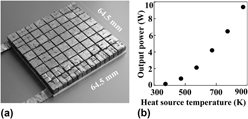No CrossRef data available.
Published online by Cambridge University Press: 01 June 2015

Thermoelectric generation is one of the strongest candidates for recovering the waste heat from industry and transportation. Some of oxides and silicides are considered to be promising thermoelectric materials because of their high oxidation resistance. Several types of modules using p-type Ca3Co4O9/n-type CaMnO3 and p-type MnSi1.75/n-type Mn3Si4Al2 have been prepared and shown around 4 kW/m2 of maximum power density. The present study described the challenging enhancement of the thermoelectric figure of merit ZT of both oxide and silicide compounds. Introduction of secondary phases and low bulk density using a partial melting method is found to be effective for reducing phonon thermal conductivity in the promising Bi2Sr2Co2Ox. The grain size and distribution of the secondary phases can be controlled by optimizing the parameters of the partial melting method. On the other hand, detailed crystallographic structure of a new n-type Mn3Si4Al2 is clarified and leads to the enhancement of the ZT values by elemental substitution.